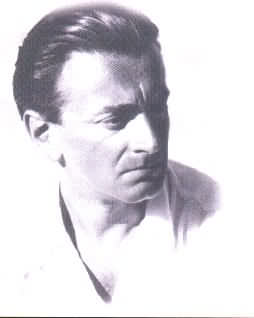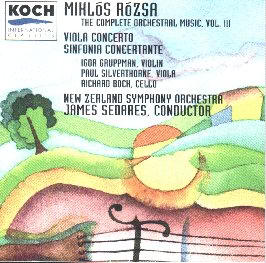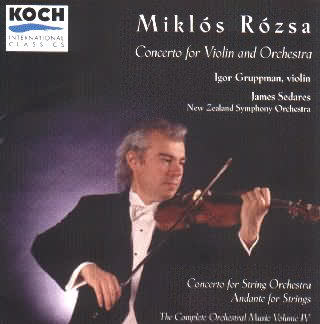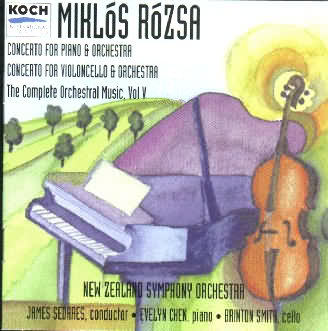
Miklós Rózsa 1946
Music Webmaster Len Mullenger
 |
The Concert music of
Miklós
RÓZSA
Miklós Rózsa 1946 |

Miklós RÓZSA (19071995) Concertos Two Koch CDs
Sinfonia Concertante Op 29 (1966) * **
Viola Concerto Op 37 (1979) ***
Igor Gruppman (violin) *
Richard Boch (cello) **
Paul Silverthorne (viola) ***
New Zealand SO/James Sedares
Koch International 3 7304 2H1
Vol. 3 The Complete Orchestral Music
66:08

Concerto for String Orchestra (1943) Op 17
Andante for strings Op 22a (1950) (arr Rózsa and Christopher Palmer)
Igor Gruppman (Violin) *
New Zealand SO/James Sedares
Koch International 3 7379 2H1
Vol. 4 The Complete Orchestral Music
64:17
Warm congratulations to Koch on this sterling series of music which other labels seem to have shied from. I am not sure why that is. Perhaps there is something about composers seen as 'film music composers' which frightens off the majors - look at what happened to Korngold. With the honourable exception of RCA(BMG), the majors largely ignored Korngold and it was only after the work of Varese Sarabande and CPO that others came including DG, EMI and Delos.
Rózsa seems to have fared less well in the 'me too' league. It has been left to Unicorn, the now defunct Pantheon and especially Koch to produce CDs of the orchestral music. Only Koch have had the courage (with some support no doubt) to develop this series across five volumes; with more to come, I would hope. We still await from Koch the masterful orchestral Tripartita previously available on Modern Masters, Volume I. London Symphony Orchestra / David Amos Harmonia Mundi HMU90 6010 (is this still available?). Vol 5 is impending and will include the piano concerto and cello concerto (previously recorded by Pennario and Starker with the Bavarian RSO and Munich PO on Pantheon).
Gruppmann and Richard Boch play with plenty of temperament delivering a characterful and dazzling performance. Poetry is also not lacking. This is a very strong performance. The glare and garish glitter of the private tape of the premiere (Miller/Aitay/Chicago SO/Leinsdorf) is fortunately missing. The performance is marginally more intense than the lovely lyrical broadcast given by Dong Suk Kang and Raphael Wallfisch on BBC Radio 3 in 1993. The names may not be seen as major league but the performances are top-flight. A lovely natural recording. I have been listening to Michael Tippett's Triple Concerto recently and was struck by similarities in themes and atmosphere. Did Tippett know the Rózsa work?
The Viola Concerto disc fields Paul Silverthorne a very well known name amongst violists although he has not recorded that much. At the start I thought of Bax's Northern Ballad No 2. The concerto has the same oppressive richness and tense darkness. The Koch first movement displays superior technical sound qualities to the Colosseum (1991) competition mentioned below. Listen to the way the harp cuts through the densest textures. It is virtually lost in the 1991 recording. The Adagio third movement can easily be heard as a surging tidal sea-picture with lovingly husky moments where we drift happily into RVW Lark Ascending territory. This movement is one of Rózsa's most perfect creations. The last movement is at first a hell-for-leather gallop (recalling de Falla in its rustic violence) driving the viola to display violinistic virtuosity but more pastoral moments intervene and interrupt the sparks and fireworks. The orchestra is alertly disciplined and shows sharp coordination.
The first commercial recording of the viola concerto was on a little known Colosseum CD (CST34.8048, 1991) with Maria Newman (the daughter of Alfred Newman) as the violist and the Nürnberger Symphoniker conducted by Richard Kaufman. That recording is, as far as I know, no longer available. Newman's throaty-toned viola and a vividly recorded orchestra make this a performance worth finding. The coupling is a selection of film music by Lee Holdridge so it is not directly comparable with the Koch disc. Slower than the Silverthorne it does allow the music to fill its lungs. I was struck several times by the Waltonian tone and shape of this music on both Koch and Colosseum discs. This is not a desperately Hungarian sounding work but it one of his most imaginative and enchanting.
Viola Concerto I II III IV
Zukerman/Pittsburgh SO/Previn world premiere 1984 (private tape)
[15:42] [5:05] [5:44] [7:08]
Maria Newman/Nurnberger SO/Kaufman world premiere recording
[14:04] [5:19] [7:01] [7:44]
Paul Silverthorne/NZSO/Sedares [13:06] [5:04] [6:32] [7:44]
In Volume 4 we have Rózsa's most famous concerto. Large chunks of it featured in the film The Private Life of Sherlock Holmes. The Concerto is up against only one piece of competition: the monumental Heifetz RCA/BMG recording on GD87963. I am not sure how it sounds in later re-issues but in my version it suffers from a technicolor blaze which is meshed with a high tension dynamic performance which for me does not relax enough.
As can be seen from the timings below, Gruppman and Sedares allow the music to expand rather than perspire. This can be heard immediately from the first bars. This redounds to the music's advantage. If you want the dazzling mesmeric approach then Heifetz is your man. Gruppman has a calmer more expansive line and one which allows the music to blossom. The first movement is a relentless creation anyway but its energy is well projected. The middle movement blossoms rapturously in the hands of the Koch team a special blend of nostalgia, The Lark Ascending and the Delius concerto (no wonder Christopher Palmer was such an enthusiast for Rózsa'a music). The more reflective music for El Cid was recalled more than once. The last movement is handled with an explosive desperation as if a torrent constantly in spate.
Violin Concerto I II III
Heifetz/Dallas SO/Walter Hendl RCA/BMG [11:21] [7:30] [7:46]
Gruppman/NZSO/Sedares Koch [13:09] [ 8:46] [ 8:51]
The Concerto for Strings is in direct competition with another Koch release featuring the Berlin SO and Isaiah Jackson and really the only issue dividing them is the coupling. The Jackson directed performance also features string works by Herrmann and Waxman. The Sedares account underlines for me the crossreferences with golden age British string music and although the Hungarian elements surface occasionally I caught myself thinking more often of Elgar's Introduction and Allegro and Bliss's Music for Strings and Howells work sharing the same name as the Rózsa. There is a slight hint of Shostakovich in the last movement, not surprising given the time of writing. No doubt Rózsa had heard the famous wartime recordings of the Leningrad Symphony or at least seen the score of this or other Russian works perhaps the sixth symphony.
The andante movement is the opening movement of the first string quartet. This is fairly dense writing quite complex. It has something of Tippett about it (Concerto for Double String Orchestra and Corelli Fantasia) as does the Concerto for Strings. What is not explained is why only this movement has been orchestrated. There is a trend here of course. Szell orchestrated Smetana's Quartet From My Life. There are orchestrations of Walton's String Quartet and of various Shostakovich Quartets. Why was this orchestration project never completed? This is an ear-tickling exercise; stimulating but only a glint of the lyrical heart we find in other Rózsa pieces. Once or twice I recalled Walter Piston in his earlier symphonies especially numbers 2 (1943) and 4 (1950).

Piano Concerto Op 31 (1966)
Cello Concerto Op 32 (1969)
Evelyn Chen (piano), Brinton Smith (cello), New Zealand SO/James Sedares
The Complete Orchestral Music Vol 5
Koch International 374022
61:45
Koch's invaluable Rózsa series is now drawing to a close with the late great Tripartita and the early unknown ballet Hungaria to come, at least amongst the major works.
Volume 5 in the series is dedicated to the late Tony Thomas. Thomas did so much to promote film music. Mr Thomas's prefatory note introduces notes by the late Christopher Palmer who died in the same year as Rózsa. Palmer was closely associated with Rózsa (and other Hollywood greats), in 1974 writing Breitkopf's little book on the composer and undertaking extensive film orchestrations. The notes give an accessible description of the music, movement by movement, but I would have valued more autobiographical background and context for the two concertos and some hint of their relationship with Rózsa's films of the 1960s.
The volume covers the remaining concerto works. Three years separate the two works. Both were written in the 1960s away from Hollywood where Rózsa was the doyen of film music undisputed since the death of Korngold in the 1950s. As a break from turning out one distinguished film score after another he would annually go to his Santa Margherita villa in Italy and produce concert scores. Latterly these were either commissions or associated with particular celebrity musicians.
The music breaks no new stylistic ground for Rózsa. It is both energetic and poetic with the former quality predominating in the piano concerto and the latter in the cello concerto. The Piano Concerto has been heard in BBC radio tapes of a version played with even greater poetry by Eric Parkin. It begins belligerently. But at 1:00 a typically ripe melody chamfers the jagged edges of the attack. However for the rest of the movement the mood alternates between Prokofievlike angularity (with a touch of jazz) and lyricism. This is a tougher work than its predecessor Piano Concerto (Spellbound). There were moments when I thought of the much earlier piano concertos by Bliss (a less concentrated work) and John Ireland and Walton's devastatingly barbed Sinfonia Concertante.
The second movement opens in gently pealing mode like Martinu's Toccata e Due Canzone. At 2:49 there is a recollection of the jewelled piano figuration which opens the last movement of Bax's Winter Legends (1930). The last movement is an alert vigoroso boiling over at 6:25 into a grand statement of the big romantic tune.
The cello concerto is quite a rare work. Sombre and rhapsodic, it is a sidestep away from the rich dark world of Bloch's Schelomo and Rubbra's Soliloquy. The second movement has some eldritch passages witness 6:25 with the cello in its highest harmonics. If you know the ghostly music in Sondheim's Sweeney Todd you now know where he got the idea from! The finale is brusque and has a Shostakovichlike élan ably despatched by Smith. Surprisingly the music of this movement often drifts agreeably into Vaughan Williams territory. The central movement is the most impressive of the three.
The performances are in the grand manner as befits the music which positively smokes with passion and sultry romance. You might be forgiven for thinking that performances from New Zealand by soloists with little or no international fame would be disappointing. After all these works were written for Pennario and Starker! In fact these are no compromise performances played with high voltage commitment and flaming ardour. The performances live and breathe. They are truly threedimensional as the closing 5 minutes of each of these concerto recordings demonstrate.
This is not the first time this pairing has been issued. In the late 1980s the Geman Pantheon company issued the same works on both cassette and later CD. As far as I know that disc is no longer available. I know it through the cassette version which preserves historically important performances by dedicatee artists Janos Starker and Leonard Pennario. Both are fiery but compromised by an unnatural closed ambience. I have not heard the CD version but would expect it to have similar qualities. In any event it appears not to be available.
The notes (English only) are good but the cover design is dull and uninspiring. With the access which Koch must have had to the Rózsa Estate I am surprised that they missed the opportunity to use family photos on the cover.
Recommended but not as an introduction to Rózsa. Anyone who has contracted the Rózsa bug will want this disc. Film music fans will want it for its relationship to the scores of the 1960s. The generalist would do well to start with the Violin Concerto or the sinfonia concertante. Two exceptional performances of the concertos well caught in fine sound.
© Robert Barnett
Return to: